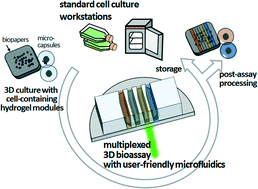User-friendly 3D bioassays with cell-containing hydrogel modules: narrowing the gap between microfluidic bioassays and clinical end-users' needs
Abstract
Cell-containing hydrogel modules as cell–hydrogel microunits for creating a physiologically relevant 3D in vivo-like microenvironment with multiple cell types and unique extracellular matrix (ECM) compositions facilitate long-term cell maintenance and bioassays. To date, there have been many important advances in microfluidic bioassays, which incorporate hydrogel scaffolds into surface-accessible microchambers, driven by the strong demand for the application of spatiotemporally defined biochemical stimuli to construct in vivo-like conditions and perform real-time imaging of cell–matrix interactions. In keeping with the trend of fostering collaborations among biologists, clinicians, and microfluidic engineers, it is essential to create a simpler approach for coupling cell-containing hydrogel modules and an automated bioassay platform in a user-friendly format. In this article, we review recent progress in hydrogel-incorporated microfluidics for long-term cell maintenance and discuss some of the simpler and user-friendly 3D bioassay techniques combined with cell-containing hydrogel modules that can be applied to mutually beneficial collaborations with non-engineers. We anticipate that this modular and user-friendly format interfaced with existing laboratory infrastructure will help address several clinical questions in ways that extend well beyond the current 2D cell-culture systems.

- This article is part of the themed collection: Lab on a Chip: Insights Issue


 Please wait while we load your content...
Please wait while we load your content...